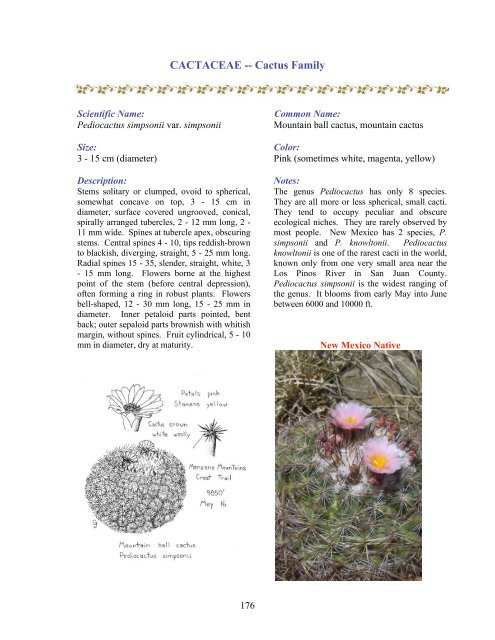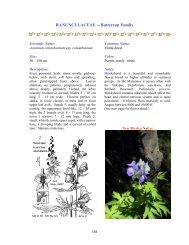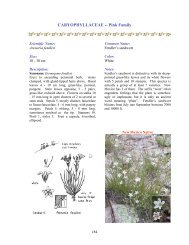BERBERIDACEAE -- Barberry Family - New Mexico Flores
BERBERIDACEAE -- Barberry Family - New Mexico Flores
BERBERIDACEAE -- Barberry Family - New Mexico Flores
You also want an ePaper? Increase the reach of your titles
YUMPU automatically turns print PDFs into web optimized ePapers that Google loves.
Scientific Name:<br />
Pediocactus simpsonii var. simpsonii<br />
Size:<br />
3 - 15 cm (diameter)<br />
CACTACEAE -- Cactus <strong>Family</strong><br />
Description:<br />
Stems solitary or clumped, ovoid to spherical,<br />
somewhat concave on top, 3 - 15 cm in<br />
diameter, surface covered ungrooved, conical,<br />
spirally arranged tubercles, 2 - 12 mm long, 2 -<br />
11 mm wide. Spines at tubercle apex, obscuring<br />
stems. Central spines 4 - 10, tips reddish-brown<br />
to blackish, diverging, straight, 5 - 25 mm long.<br />
Radial spines 15 - 35, slender, straight, white, 3<br />
- 15 mm long. Flowers borne at the highest<br />
point of the stem (before central depression),<br />
often forming a ring in robust plants. Flowers<br />
bell-shaped, 12 - 30 mm long, 15 - 25 mm in<br />
diameter. Inner petaloid parts pointed, bent<br />
back; outer sepaloid parts brownish with whitish<br />
margin, without spines. Fruit cylindrical, 5 - 10<br />
mm in diameter, dry at maturity.<br />
176<br />
Common Name:<br />
Mountain ball cactus, mountain cactus<br />
Color:<br />
Pink (sometimes white, magenta, yellow)<br />
Notes:<br />
The genus Pediocactus has only 8 species.<br />
They are all more or less spherical, small cacti.<br />
They tend to occupy peculiar and obscure<br />
ecological niches. They are rarely observed by<br />
most people. <strong>New</strong> <strong>Mexico</strong> has 2 species, P.<br />
simpsonii and P. knowltonii. Pediocactus<br />
knowltonii is one of the rarest cacti in the world,<br />
known only from one very small area near the<br />
Los Pinos River in San Juan County.<br />
Pediocactus simpsonii is the widest ranging of<br />
the genus. It blooms from early May into June<br />
between 6000 and 10000 ft.<br />
<strong>New</strong> <strong>Mexico</strong> Native




